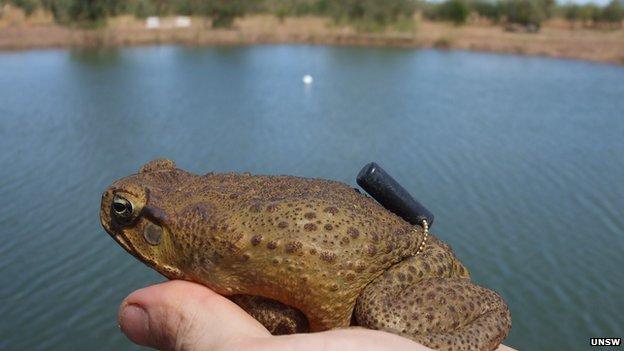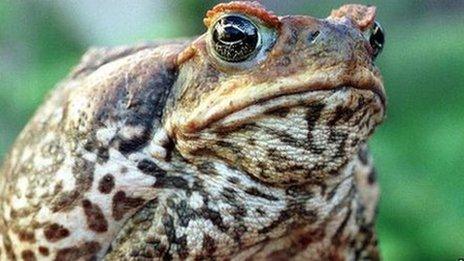Australian study says fences could halt cane toad menace
- Published

Some cane toads are fitted with tracking devices to plot their spread
Special fences built around dams in arid parts of Australia could help eradicate the menace of cane toads, according to new research.
The toads, regarded as poisonous pests, are drawn to the dams by the need for water and die in large numbers if fences hold them back, scientists said.
The animals were brought to Australia in the 1930s to get rid of beetles.
They have since spread from Queensland into the Northern Territories, New South Wales and Western Australia.
Their numbers have grown because they have almost no natural predators and their toxins kill native animals that normally feed on frogs.
Various methods to eradicate the toads have been tried, including mass culls by teams of volunteers, but have only had limited success.
Now a study led by experts at the University of New South Wales (UNSW) says toad-proof fences around dams may stem their spread because most areas the toads will invade in future are semi-arid or arid.
The dams are built to provide water for livestock but are a magnet for the toads.
Numbers "suppressed"
Researchers built small fences from shade cloth around three dams in the Victoria River region of the Northern Territory and maintained them for a year.
They found that the toads were unable to jump over them or burrow under.
"The toads were still attracted to the water but they died en masse while attempting to settle at the fenced dams," said the study's lead author, UNSW Associate Professor Mike Letnic.
"Their numbers remained suppressed for a further year. By comparison, there were 10 to 100 times more toads living at the unfenced dams that were used as controls in the study," he said.
The team has suggested that livestock farmers and wildlife agencies work together to fence out the toads or replace the dams with water tanks.
"If conducted strategically, excluding toads from man-made water sources could effectively control their populations across large areas of Australia," said Prof Letnic.
The research team included scientists from the University of Technology, Sydney, and the University of Melbourne.
Cane toads are native to South America but were introduced to Australia in 1935 to control beetles that infested sugar cane.
- Published7 April 2012
